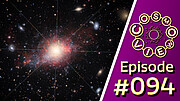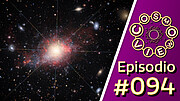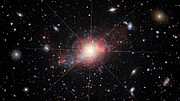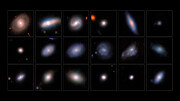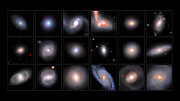An image of the spiral galaxy NGC 1068 (Messier 77) obtained by the European Southern Observatory’s (ESO) Very Large Telescope (VLT). The galaxy has a distance of 14.4 Mpc (47 million light-years) and is one of the nearest galaxies with an active galactic nucleus. © ESO
A new type of observation reveals what makes the cores of active galaxies glow
Using the Large Binocular Telescope Interferometer, a team of astronomers led by scientists from the Max Planck Institute for Astronomy (MPIA) and the University of Arizona (UofA) has disentangled the sources of infrared radiation near the supermassive black hole at the centre of the galaxy NGC 1068. They discovered that the surrounding dusty wind is heated by the hot central accretion disk and shocks generated by a collimated gas jet. These findings and additional features support the unified model of active galactic nuclei, which explains their varying appearances.
Active galactic nuclei (AGN) are supermassive black holes at the centre of certain galaxies. When these black holes attract matter, a quickly rotating disk of hot gas forms, releasing enormous amounts of energy before plunging into the black hole. Such AGN belong to the most energetic phenomena observed in space. As a result, they also influence processes occurring in their host galaxies. The details are a field of ongoing research.
A team around former MPIA student Jacob Isbell, now a postdoc at the Steward Observatory of the University of Arizona, aimed the Large Binocular Telescope (LBT) at the galaxy NGC 1068, also known as Messier 77, to study the minute details in its centre at thermal infrared wavelengths. This galaxy is one of the nearest with an AGN. The observations had the proper spatial resolution to focus on the components emitting this kind of radiation. The results are now published in Nature Astronomy.
An optical image of the spiral galaxy NGC 1068 (Messier 77) overlaid with an insert with the image obtained by the Large Binocular Telescope Interferometer (LBTI) at thermal infrared wavelengths (8.7 micrometres). The false-colour image depicts the brightness variation of mostly warm dust surrounding the supermassive black hole in the centre of that galaxy. By comparing the image with previous observations at various wavelengths, the researchers identified the hot and bright disk of gas and dust and the collimated gas jet as their heat sources. The components identified in the image confirm the unified model of active galactic nuclei. © ESO / J. Isbell (UofA, MPIA) / MPIA
Disentangling the AGN components
The bright, hot disk surrounding the supermassive black hole emits an enormous amount of light that drives the dust apart as if the individual grains were tiny sails – a phenomenon known as radiation pressure. The images revealed the glowing dust, a warm, outflowing wind caused by that mechanism, which was heated by the hot central disk.
Simultaneously, farther out, much material is way brighter than it should have been if it was illuminated only by the bright accretion disk. By comparing the new images to past observations at various wavelengths, the researchers tied this finding to a collimated jet of hot gas emanating from the disk centre. While blasting through the galaxy, it hits and heats clouds of molecular gas and dust, leading to the unexpected bright infrared signal. Such jets are particularly bright at radio wavelengths when interacting with gas and particles in the environment around the supermassive black holes.
Altogether, the result confirms the so-called unified model of AGN. It promotes a configuration of a supermassive black hole in the centre of a galaxy, which attracts and collects gas and dust from the surrounding host galaxy, accumulating in an inner bright and hot disk. In addition, an outer, larger structure of cooler, outflowing material obstructs the view. Finally, a powerful gas jet is ejected from the centre. Different components are exposed to the observer, depending on the viewing angle. Although the observed features vary significantly between objects, the unified model proposes that those variations derive from intrinsically similar configurations of structures around the supermassive black hole, powering the AGN phenomenon.
View from the dome of the Large Binocular Telescope (LBT) through the open dome doors. In the foreground are the two large primary mirrors with the support structure for the secondary mirrors. © Marc-André Besel & Wiphu Rujopakarn
LBT – A precursor of future segmented-mirror telescopes
The LBT is located on Mount Graham, northeast of Tucson, USA, and operates its two 8.4-metre mirrors independently of each other, essentially functioning like two separate telescopes mounted side by side and aligned in parallel. MPIA is a member of the LBT Corporation via the LBT-Beteiligungsgesellschaft (holding company), which supplies 25% of all operations funding.
Combining the light from both mirrors, the LBT becomes an imaging interferometer (LBTI), allowing for approximately three times higher resolution observations than would be possible with each mirror on its own. To stabilize this high-resolution imaging machine, LBTI regularly deploys the OVMS+ vibration control system developed under MPIA leadership by MPIA’s Jörg-Uwe Pott to enable these challenging observations of distant galaxies. This imaging technique has been successfully employed to study volcanoes on the surface of Jupiter’s moon Io. The Jupiter results encouraged the researchers to use the interferometer to look now at an AGN.
“The AGN within the galaxy NGC 1068 is especially bright, so it was the perfect opportunity to test this method,” Isbell said. “These are the highest resolution direct images of an AGN taken so far.” In this context, direct images mean, they contain all faint and diffuse radiation from the structures observed. In contrast, images from other interferometers, such as the Very Large Telescope Interferometer (VLTI), are reconstructed from computations interpolating the missing imaging information.
Combining both mirrors produces images directly on the detector, very much like telescopes with segmented mirrors do, such as the James Webb Space Telescope, as well as the future 25-metre Giant Magellan Telescope (GMT) and the upcoming 39-metre Extremely Large Telescope (ELT), both being built in Chile. This way, Isbell and his collaborators produced the first ELT-like images of an AGN. As a result, the LBTI observations resolved individual features of up to 20 light-years at a distance of 47 million light-years. Previously, the various processes were blended due to low resolution, but now it is possible to view their individual impact.
A test for future observations
The study shows that the environments of AGN can be complex. The new findings help us understand the intricate ways in which AGN interact with their host galaxies. By probing distant galaxies in the early universe, when the galaxies were still young, we cannot achieve the same level of detail. Therefore, these results are like a local analogue.
“This type of imaging can be used on any astronomical object,” Isbell said. “We’ve already started looking at disks around stars and very large, evolved stars, which have dusty envelopes around them.”
Additional information
The MPIA team involved in this study comprised Jacob W. Isbell (now Steward Observatory, The University of Arizona, Tucson, USA) and Jörg-Uwe Pott.
Other researchers included Steve Ertel (Steward Observatory and Large Binocular Telescope Observatory, The University of Arizona, Tucson, USA), Gerd Weigelt (Max Planck Institute for Radio Astronomy, Bonn, Germany), and Marko Stalevski (Astronomical Observatory, Belgrade, Serbia and Sterrenkundig Observatorium, Universiteit Gent, Belgium).
This press release is based on the one published by the University of Arizona.
Contacts:
Dr. Markus Nielbock
Press and outreach officer
+49 6221 528-134
pr@mpia.de
MPIA press department
Max Planck Institute for Astronomy, Heidelberg, Germany
Dr. Jacob W. Isbell
jwisbell@arizona.edu
Jacob Isbell / UofA
Steward Observatory, The University of Arizona, Tucson, AZ, USA
Dr. Jörg-Uwe Pott
+49 6221 528-202
jpott@mpia.de
Jörg-Uwe Pott / MPIA
Max Planck Institute for Astronomy, Heidelberg, Germany
Original publication
Jacob W. Isbell, S. Ertel, J.-U. Pott et al.
Direct imaging of active galactic nucleus outflows and their origin with the 23 m Large Binocular Telescope
Nature Astronomy (2025)
Source | DOI
Video
Links
Nature Astronomy embargo policy
Ring of cosmic dust hides a supermassive black hole in Active Galactic Nucleus
February 16, 2022
Image of warm dust emission from the heart of an active galactic nucleus shows a ring-like structure that obscures the black hole
more










